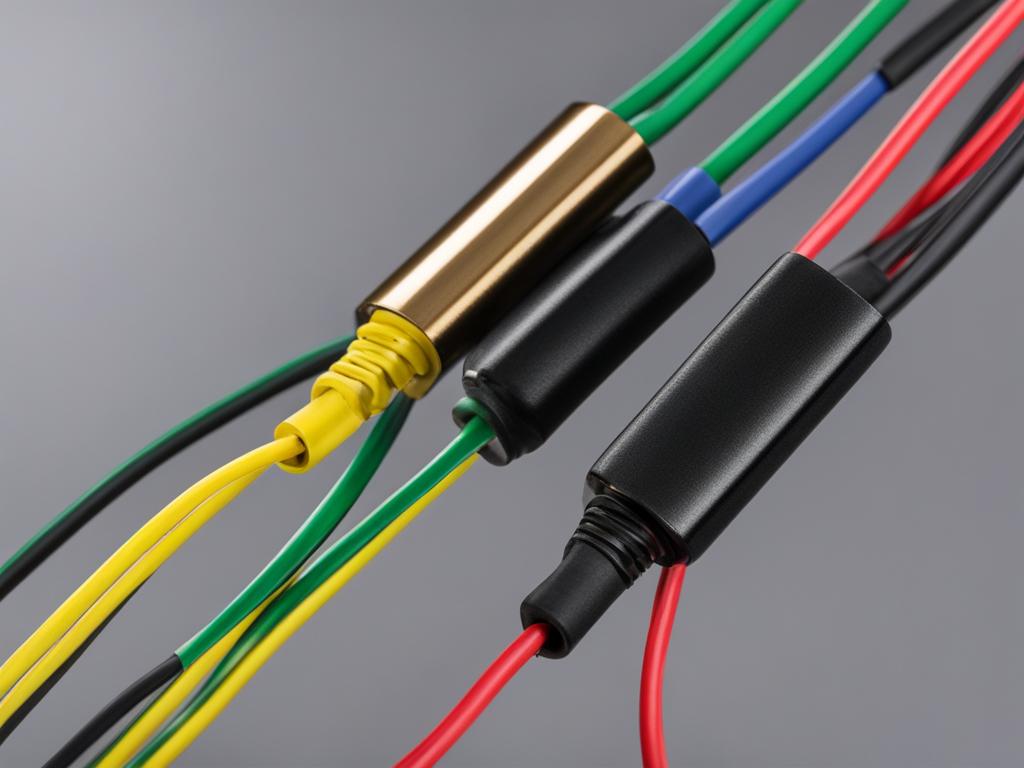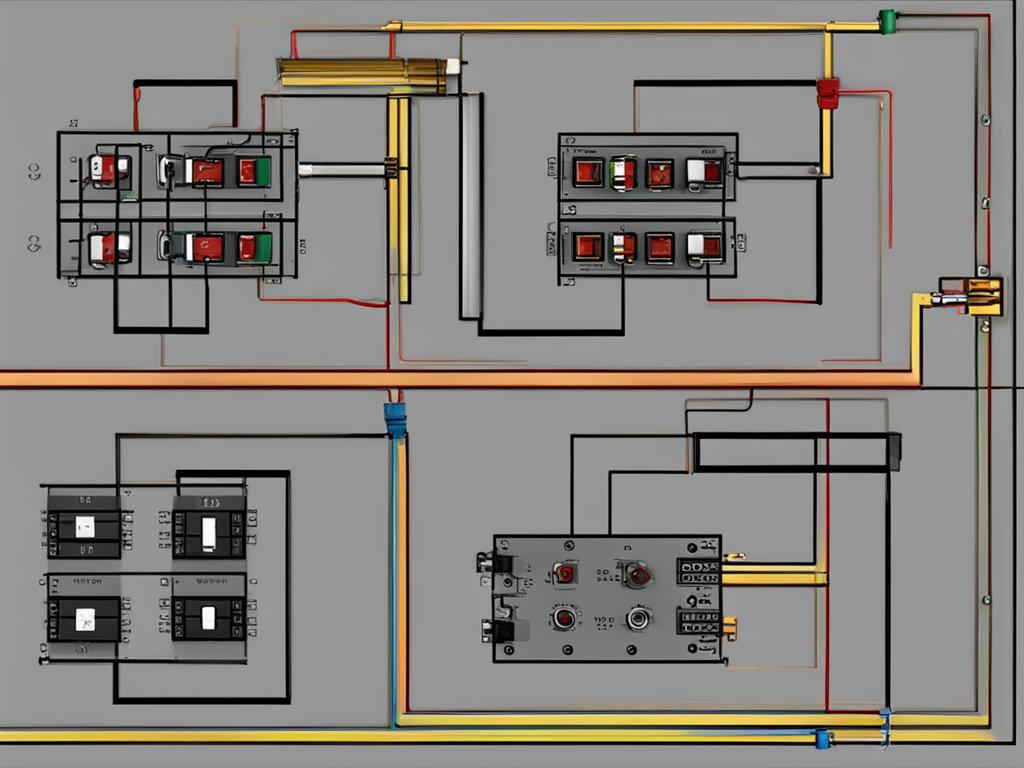Choosing the right electrical cable for your wiring needs is crucial to ensure safe and efficient electrical installations. Two common options are 14/2 and 14/3 electrical cables. In this article, we will explore the differences between these two cables, their advantages and disadvantages, and help you determine the best choice for your specific requirements.
Key Takeaways:
- 14/2 electrical cable contains a black wire, a white wire, and a bare copper wire, while 14/3 electrical cable has an additional red wire.
- The black wire carries current, the white wire is the neutral wire, the bare copper wire is the ground wire, and the red wire is used for specific applications.
- 14/2 wire is commonly used for lighting circuits and power outlets, while 14/3 wire is necessary for three-way switches, multibranch circuits, and other specific applications.
- Wire size is measured using the American Wire Gauge (AWG) system, with larger AWG numbers indicating thinner wires.
- Choosing the right wire size is essential to ensure it can effectively carry the required current for the connected devices and prevent safety hazards.
American Wire Gauge (AWG)
American Wire Gauge (AWG) serves as the standard system for measuring the thickness of electrical wires. By understanding the concept of AWG, individuals can make informed decisions when it comes to selecting the appropriate wire size for their electrical installations.
The AWG system assigns a specific number to each wire size, with higher AWG numbers representing thinner wires. For example, 14 AWG wire is thicker than 18 AWG wire. The sizes of wires climb again beyond 1 AWG, with the lower numbers indicating thicker wires.
The thickness of a wire directly affects its capacity to carry current. Thicker wires have a larger cross-sectional area, allowing them to conduct higher current loads without overheating. On the other hand, thinner wires have a smaller capacity to carry current and are suitable for lower-load applications.
When comparing wire sizes, it’s crucial to consider the specific needs of the electrical circuit in question. For example, lighting circuits and power outlets in bedrooms and offices often require 14 AWG wire to accommodate the typical 15-amp load.
Let’s take a closer look at the comparison between 14/2 and 14/3 wire sizes:
| Wire | Number of Conductors | Wire Diameter (AWG) |
|---|---|---|
| 14/2 | 2 Conductors + Ground | 14 |
| 14/3 | 3 Conductors + Ground | 14 |
The table above illustrates that both 14/2 and 14/3 wires have the same wire diameter of 14 AWG. However, they differ in terms of the number of conductors, with the 14/3 wire having an additional conductor compared to the 14/2 wire. This additional conductor in the 14/3 wire enables its use in specific applications such as three-way switches and multibranch circuits.
The image above visually demonstrates the concept of American Wire Gauge (AWG) and the relationship between wire size and thickness.
Understanding the significance of AWG and wire sizes is crucial for ensuring the safe and efficient functioning of electrical circuits. By selecting the appropriate wire thickness based on the specific electrical load requirements, individuals can prevent overheating, reduce the risk of electrical hazards, and optimize the performance of their electrical installations.
Purpose and Applications of Different Wire Sizes
Wires come in different sizes to fulfill specific purposes and applications. The wire size, measured in American Wire Gauge (AWG), directly impacts its capacity to carry current and determines its suitability for different electrical needs. Let’s explore the purposes and applications of various wire sizes to help you make informed decisions when selecting the right wire for your electrical projects.
Thin Wires: 18 AWG and Below
Thin wires, such as 18 AWG and below, are ideal for low-voltage applications where power demands are relatively low. These wires find common use in devices like thermostats, doorbells, and low-power lighting fixtures. Their smaller size makes them more flexible and easier to work with, especially in tight spaces.
Medium Wires: 16 AWG to 12 AWG
Medium-sized wires, ranging from 16 AWG to 12 AWG, are suitable for a wide range of residential and commercial applications. They can handle higher power loads and are commonly used for lighting circuits, power outlets in bedrooms and offices, and general-purpose wiring. These wires provide sufficient current-carrying capacity for devices like televisions, computers, and kitchen appliances.
Thick Wires: 10 AWG and Above
Thick wires, such as 10 AWG and above, are designed for heavy-duty applications that require a higher current-carrying capacity. These wires are commonly used for powering appliances like electric ovens, air conditioning units, and electric vehicle charging stations. Their larger size allows them to handle the significant power demands of these devices safely and efficiently.
Understanding the purpose and applications of different wire sizes is crucial for selecting the right wire for your specific electrical needs. Choosing the appropriate wire size ensures optimal performance, minimizes the risk of overheating or electrical hazards, and provides a reliable electrical infrastructure for your home or business.
| Wire Size | Uses | |
|---|---|---|
| 18 AWG and below | – Low-voltage applications | – Thermostats, doorbells, and low-power lighting fixtures |
| 16 AWG to 12 AWG | – Residential and commercial applications | – Lighting circuits, power outlets, and general-purpose wiring |
| 10 AWG and above | – Heavy-duty applications | – Appliances like ovens, air conditioning units, and electric vehicle charging stations |
Number of Conductors in Electrical Cables
When it comes to electrical cables, the number of conductors can vary depending on the specific wiring needs and electrical requirements. In the case of 14/2 wire, there are two conductors and a ground wire, making it suitable for most residential applications. The two conductors typically consist of a black wire and a white wire, with the black wire carrying the current and the white wire acting as the neutral wire. The ground wire is essential for safety and is responsible for directing any potential electrical faults to the ground.
However, in certain scenarios where additional conductors are required, such as for three-way switches or multibranch circuits, 14/3 wire is used instead. This type of wire contains three conductors along with a ground wire. The additional conductor in the 14/3 wire is typically colored in red and is utilized for specific applications that involve multiple switches or complex circuit setups.
The number of conductors in an electrical cable is crucial in determining its compatibility with the specific wiring setup and the electrical devices or appliances connected to it. By understanding the number of conductors required for different electrical applications, individuals can ensure the safe and efficient flow of electricity throughout their wiring systems.
Benefits of using 14/2 wire:
- Suitable for most residential applications
- Provides adequate current-carrying capacity
- Cost-effective option for standard wiring needs
Benefits of using 14/3 wire:
- Enables the use of three-way switches for enhanced lighting control
- Allows for the creation of multibranch circuits
- Provides flexibility for specific wiring configurations
Understanding the number of conductors in electrical cables, such as the difference between 14/2 and 14/3 wire, is essential for proper wire selection and successful electrical installations. By considering the specific wiring requirements and the need for additional conductors, individuals can choose the appropriate wire type to meet their electrical needs effectively.
Different Uses of 14/2 and 14/3 Wire
When it comes to electrical wiring, understanding the different uses of 14/2 and 14/3 wire is crucial. These wires have specific applications and knowing how to choose the right one can ensure efficient and safe electrical installations.
14/2 Wire Uses: 14/2 wire is commonly used for a variety of applications that require a 15-amp capacity. Some of the common uses include:
- Lighting circuits: 14/2 wire is suitable for powering light fixtures in areas like living rooms, bedrooms, and offices.
- Bedroom and office outlets: It provides enough power for devices like TVs, alarm clocks, and computers.
- Other general-purpose circuits: 14/2 wire can be used for other general 15-amp circuits in residential settings.
14/3 Wire Uses: 14/3 wire is designed for more specific applications that require additional conductors. Some of the specific uses of 14/3 wire include:
- Three-way switches: In three-way switch setups, where multiple switches control a single light fixture, 14/3 wire is necessary.
- Multibranch circuits: 14/3 wire is used in multibranch circuits where separate circuits share a common neutral wire.
- 240V circuits: It is also suitable for 240V circuits that require a double-pole breaker and provide higher voltage for specific appliances.
- Hardwired interconnecting smoke detector systems: 14/3 wire is commonly used for hardwired smoke detector setups where multiple detectors are interconnected.
Knowing the specific uses of 14/2 and 14/3 wire helps in determining the appropriate choice for different electrical requirements. Whether you need to power lighting circuits, outlets, or require additional conductors for specific applications, understanding these wires’ applications is essential.

Understanding Wire Options for Different Loads
The capacity of a wire to carry electrical current depends on its size. Larger wires have a higher wire capacity and are capable of supporting heavier electrical loads, while smaller wires are suitable for lower loads. When selecting the appropriate wire size, it is crucial to consider the specific electrical load requirements of the devices or appliances being powered. This ensures that the wire can handle the necessary current without becoming overloaded or posing a safety hazard.
For example, if you are installing wiring for a lighting circuit in your home, you need to determine the electrical load that the circuit will carry. This will help you determine the appropriate wire size to ensure safe and efficient operation. Choosing a wire with insufficient capacity for the electrical load can result in overheating, reduced performance, or even electrical fires.
Selecting the Right Wire Size
When it comes to wire size selection, it’s important to consult the National Electric Code (NEC) or a qualified electrician for specific guidelines and requirements. However, here is a general overview:
| Wire Gauge (AWG) | Recommended Maximum Current | Typical Applications |
|---|---|---|
| 14 | 15 amps | Residential lighting circuits, general-purpose outlets |
| 12 | 20 amps | Kitchens, bathrooms, laundry rooms, power outlets |
| 10 | 30 amps | Electric ovens, water heaters, air conditioners |
Note: This table provides a general guide, but it is important to consider specific circuit requirements and electrical codes for accurate wire size selection.
Consequences of Incorrect Wire Size
Using an undersized wire for a higher electrical load can lead to voltage drop, increased resistance, decreased electrical efficiency, and even damage to the wire or connected devices. On the other hand, using an oversized wire for a lower electrical load is unnecessary and may result in higher costs for materials.
It is crucial to select the right wire size based on the electrical load requirements of your specific applications. By choosing the correct wire size, you can ensure the safety, efficiency, and reliability of your electrical system.
Choosing the Right Wire Size for Specific Circuits
The selection of the appropriate wire size for a specific circuit is crucial to ensure optimum performance and electrical safety. Several factors need to be considered when determining the wire size, including the type of devices or appliances connected to the circuit and the electrical load they require.
For circuits that power high-powered devices like electric ovens and washing machines in kitchens and bathrooms, it is recommended to use 12 AWG wire or larger to handle the increased electrical load effectively. Using a wire size that is too small for these heavy-duty applications can lead to overheating, which poses a potential fire hazard.
When choosing the wire size, it is important to refer to the applicable electrical codes and regulations to ensure compliance with safety standards. Consulting with a professional electrician can provide valuable insights into the specific requirements of your circuits and help you make an informed decision regarding wire size selection.

“Choosing the right wire size is essential to ensure electrical safety and prevent potential hazards. It is worth investing in the proper wire size to avoid overheating and potential fire risks.”
Conclusion
Understanding the differences between 14/2 and 14/3 electrical cables is crucial when it comes to selecting the right wires for your specific applications. Factors such as wire size, number of conductors, and intended uses all play a significant role in determining the most suitable wiring option for your electrical requirements.
By carefully considering the electrical needs of your circuits and devices, you can confidently choose the appropriate wire size and configuration to ensure efficient and safe electrical installations. Whether you’re working on lighting circuits, bedroom outlets, or more complex setups like three-way switches or multibranch circuits, understanding the benefits and limitations of 14/2 and 14/3 wires will guide you towards the best choice.
If you have any doubts or uncertainties about wire selection and installation, it is always recommended to consult with a professional electrician. Their expertise will ensure that your wiring meets the necessary electrical standards and regulations while addressing any specific challenges or requirements your project may have. With proper wire selection and installation, you can create a reliable electrical system that will meet your needs for years to come.
FAQ
What is the difference between 14/2 and 14/3 electrical cables?
14/2 wire has two conductors and a ground wire, while 14/3 wire has three conductors and a ground wire. The additional conductor in 14/3 wire allows for specific applications like three-way switches and multibranch circuits.
How does wire size affect the performance of electrical circuits?
Wire size, measured in American Wire Gauge (AWG), determines the capacity to carry current. Thicker wires like 14 AWG can carry more current than thinner wires like 18 AWG.
What are the different purposes and applications of wire sizes?
Thicker wires like 14 AWG are used for lighting circuits and power outlets, while thinner wires like 18 AWG are suitable for low-voltage applications such as thermostats and doorbells. Larger wire sizes like 10 AWG and 8 AWG are used for appliances that require more current.
How many conductors do 14/2 and 14/3 wires have?
14/2 wire has two conductors and a ground wire, while 14/3 wire has three conductors and a ground wire.
What are the specific uses of 14/2 and 14/3 wire?
14/2 wire is commonly used for lighting circuits, bedroom and office outlets, and other applications with a 15-amp capacity. 14/3 wire is used for three-way switches, multibranch circuits, 240v circuits, and hardwired interconnecting smoke detector systems.
How does wire size selection impact electrical loads?
Larger wire sizes have a higher current-carrying capacity and can support heavier electrical loads, while smaller wire sizes are suitable for lower loads.
How do I choose the right wire size for specific circuits?
The right wire size depends on various factors such as the type of devices or appliances connected to the circuit and their electrical load requirements. It is important to choose an appropriate wire size to ensure electrical safety and prevent overheating or potential fire hazards.
What are the key considerations when selecting electrical wires?
Understanding the differences between 14/2 and 14/3 wire, considering wire size, number of conductors, and specific uses are important factors to consider when selecting electrical wires for various applications.
